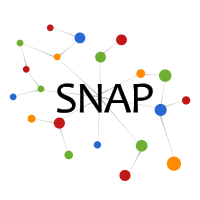Poypharmacy side-effect association network
Dataset information
This is a network of polypharmacy side-effects. Nodes represent drugs and edges represent different types of side effects that are associated with drug pairs. Edges indicate which side effects a patient will likely experience if he takes two drugs together (i.e., a drug combination). Such side effects are known as polypharmacy side-effects, as they are associated with drug pairs (or higher-order drug combinations) and cannot be attributed to either individual drug in the pair (in a drug combination).
| Dataset statistics | |
|---|---|
| Nodes | 645 |
| Edges | 63473 |
| Nodes in largest SCC | 645 |
| Fraction of nodes in largest SCC | 1.000000 |
| Edges in largest SCC | 63473 |
| Fraction of edges in largest SCC | 1.000000 |
| Average clustering coefficient | 0.811445 |
| Number of triangles | 11489282 |
| Fraction of closed triangles | 0.354259 |
| Diameter (longest shortest path) | 3 |
| 90-percentile effective diameter | 1.864073 |
| Average side effects per edge | 73.250689 |
| Median side effects per edge | 53 |
| Standard deviation of side effects per edge | 66.053302 |
Polypharmacy side-effect information was generated based on national adverse event reporting systems.
References
- Modeling polypharmacy side effects with graph convolutional networks. Marinka Zitnik, Monica Agrawal, and Jure Leskovec. Bioinformatics. 2018.
Presented at ISMB 2018
- Data-driven prediction of drug effects and interactions. Tatonetti, Nicholas P., et al. Science Translational Medicine. 2012.
Files
| File | Size | Description |
|---|---|---|
| ChChSe-Decagon_polypharmacy.csv.gz | 232.8MB | Side effects of drug pairs |



